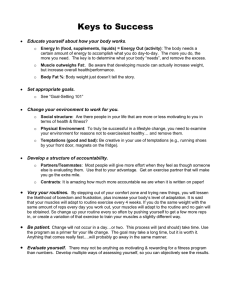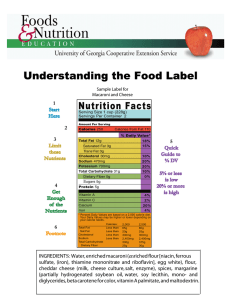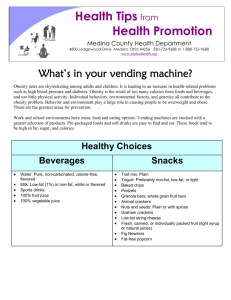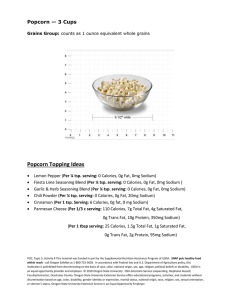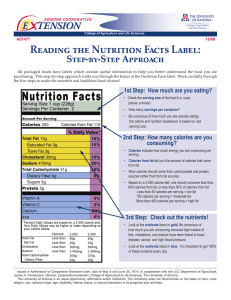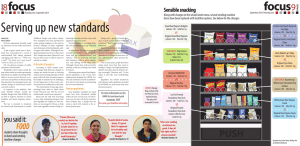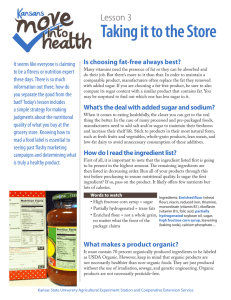Week 8 - Appleton Area Health Services
advertisement
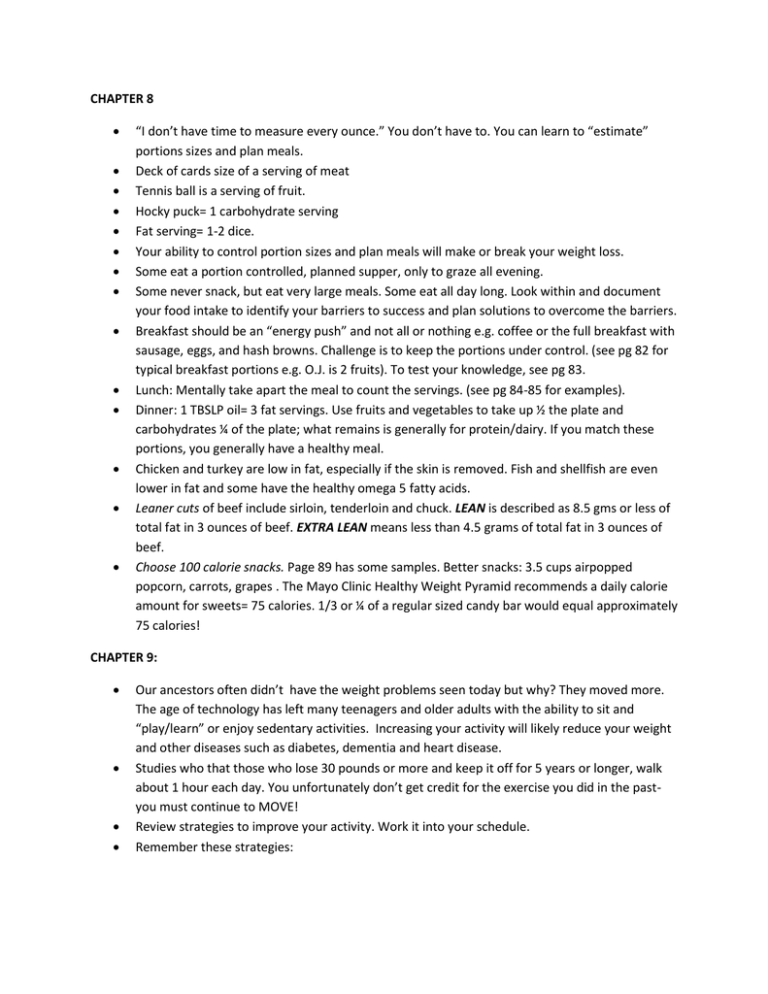
CHAPTER 8 “I don’t have time to measure every ounce.” You don’t have to. You can learn to “estimate” portions sizes and plan meals. Deck of cards size of a serving of meat Tennis ball is a serving of fruit. Hocky puck= 1 carbohydrate serving Fat serving= 1-2 dice. Your ability to control portion sizes and plan meals will make or break your weight loss. Some eat a portion controlled, planned supper, only to graze all evening. Some never snack, but eat very large meals. Some eat all day long. Look within and document your food intake to identify your barriers to success and plan solutions to overcome the barriers. Breakfast should be an “energy push” and not all or nothing e.g. coffee or the full breakfast with sausage, eggs, and hash browns. Challenge is to keep the portions under control. (see pg 82 for typical breakfast portions e.g. O.J. is 2 fruits). To test your knowledge, see pg 83. Lunch: Mentally take apart the meal to count the servings. (see pg 84-85 for examples). Dinner: 1 TBSLP oil= 3 fat servings. Use fruits and vegetables to take up ½ the plate and carbohydrates ¼ of the plate; what remains is generally for protein/dairy. If you match these portions, you generally have a healthy meal. Chicken and turkey are low in fat, especially if the skin is removed. Fish and shellfish are even lower in fat and some have the healthy omega 5 fatty acids. Leaner cuts of beef include sirloin, tenderloin and chuck. LEAN is described as 8.5 gms or less of total fat in 3 ounces of beef. EXTRA LEAN means less than 4.5 grams of total fat in 3 ounces of beef. Choose 100 calorie snacks. Page 89 has some samples. Better snacks: 3.5 cups airpopped popcorn, carrots, grapes . The Mayo Clinic Healthy Weight Pyramid recommends a daily calorie amount for sweets= 75 calories. 1/3 or ¼ of a regular sized candy bar would equal approximately 75 calories! CHAPTER 9: Our ancestors often didn’t have the weight problems seen today but why? They moved more. The age of technology has left many teenagers and older adults with the ability to sit and “play/learn” or enjoy sedentary activities. Increasing your activity will likely reduce your weight and other diseases such as diabetes, dementia and heart disease. Studies who that those who lose 30 pounds or more and keep it off for 5 years or longer, walk about 1 hour each day. You unfortunately don’t get credit for the exercise you did in the pastyou must continue to MOVE! Review strategies to improve your activity. Work it into your schedule. Remember these strategies: 1. Better together: do things with another person or pet. If you only cut calories and don’t’ exercise, you may lose muscle as well as body fat and your health not benefit much. 2. 3500 calorie reduction in one week to lose one pound. 3. Physical activity is any movement you do that burns calories from gardening to walking. 4. Exercise is a planned, repetitive form of physical activity that improves fitness such as swimming, bicycling, a brisk walk or lifting weights. 5. All activity you do beyond your normal activity COUNTS! 6. Brisk walking for one hour burns 300 calories (think about how much food is eaten and you lose only 300 calories for walking!). The more intense the activity, the more calories burned. 7. East into exercise. 8. Don’t let your physical limitations be an excuse not to exercise. Think about the Special Olympics and the challenges that some of the participants overcome. 9. Check with your provider. 10. Start where you are and gradually build endurance. Walk before you run. Do what you enjoy. Pick a time and stick to it. Warm up. Break things up if you have to. Listen to your body (rest if you must). Use a realistic strategy (if not a morning person, exercise at night). 11. Keep an activity journal. (see pages 96-97 for adding activities in your day). See also Chapter 18 (pgs 172-179). CHAPTER 10: This chapter reviews the Lose it! And Live it! Topics. Reviews the steps. It helps to be sure you are “on track”. Pages to review under each step is included (see pg 101). Your ultimate goal: you don’t want to be on a diet forever. Goal is to find a way of eating that helps you keep the weight off; a lifestyle that is sustainable. Next week: Part three of your book provides you important support information like pyramid servings, action guide and healthy recipes. Please bring in healthy meals or recipes to share. Food labels to talk about. Your favorite spices. Please review the following chapters for next meeting: Chapter 11: Finding your healthy weight. Chapter 12 Understanding nutrition and weight control. Chapter 13: the Healthy Weight Pyramid.



